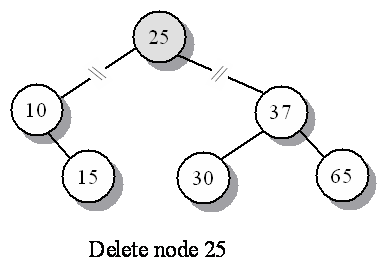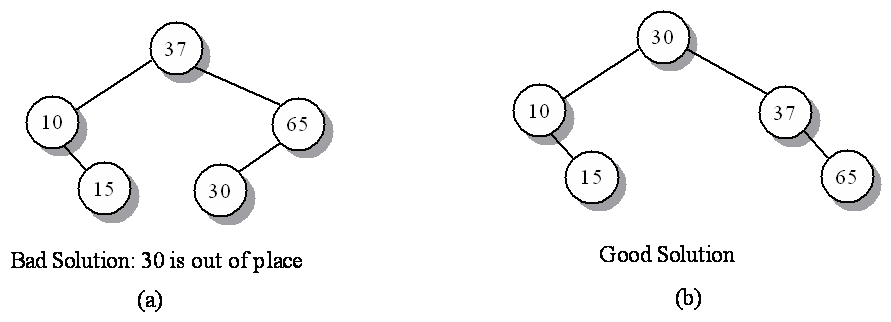
A binary search tree has the property, for any node x be a node in a binary search tree,
30
/ \
15 40
/ \ / \
9 18 38 44
/ / / \
5 17 31 39
/
1
For a BST an inorder traversal outputs the nodes in order.
We look at pseudocode for BST common operations.
Binary search tree search, recursive.
bstSearch(n, v) // node n, value v
if (n == 0 || v == n->value) // not in tree or n has the target
return n
else if (v < n->value) // search left subtree
return bstSearch(n->left, v)
else if (v > n->value) // search right subtree
return bstSearch(n->right, v)
Binary search tree search, iterative.
bstSearch(n, v) // node n, value v
while (n != 0 && v != n->value)
if (v < n->value)
n = n->left // search left subtree
if (v > n->value)
n = n->right // search right subtree
endwhile
return n

Binary search tree minimum. The leftmost child has the minimum value.
bstMin(n) // node n
while (n->left != 0)
n = n->left
endwhile
return n
What change is needed for maximum?
Binary search tree insertion. If the tree is not null make the new node the root, otherwise search for leaf location where inserting a new node will maintain the BST property.
bstInsertion(T, n) // T is a tree, n is a node
root = T.root
if (root == 0) // empty tree
T.set_root(n)
else
// Do a binary search to find where node should go. Keep
// track of each node's parent as we go down through the tree.
x = root
while (x != 0) // there is at least 1 iteration
par_x = x // save parent of x
if (n->value < x->value)
x = x->left // move to left subtree
else
x = x->right // move to right subtree
endif
endwhile
// Do insert, x is null, par_x is parent of x
if (n->value < par_x->value)
par_x->left = n
else
par_x->right = n
The resulting tree is not necessarily balanced.
Create the binary tree that results from inserting the following sequences of values (in the given order):
Binary search tree successor. Think of the inorder traversal. Two cases:
n has a right child -
n is the minimum of
n's
right subtree.
n doesn't have a right child -
n.
Or, find the subtree of which
n
is the maximum, the parent of the root of that subtree
is
n's
successor.
Requires a parent link.
Ex., Given the tree below find: successor(8), successor(22), successor(19), successor(9), successor(29).
22
/ \
10 27
/ \ / \
2 17 25 29
/ \
15 19
/ \ \
12 16 20
\
13
bstSuccessor(n) // node n
if (n->right != 0)
return bstMin(n->right) // find min of the right subtree
else
y = n->parent
x = n
while (y != 0 &&
x == y->right) // true if x is a right child of its parent
x = y // move x up
y = y->parent // move y up
endwhile
return y // y is parent of x and x is left child of y
The binary search tree delete has the complication that a node may have children which are orphaned when the parent is deleted.
Binary search tree delete, 3 cases,
d is the node to be deleted:
| number of children |
action |
|---|---|
| 0 | delete node d
|
| 1 | splice out node d
|
| 2 |
More complicated, do the following:
|


node* copyTree (n) // n points to root of subtree to copy
if (n == 0)
return 0
else
new_left = copyTree(n->left)
new_right = copyTree(n->right)
new_node = node(new_left, new_right, n->data)
return new_node
What traversal is used?
deleteTree(n)
if (n != 0)
deleteTree(n->left)
deleteTree(n->right)
delete n
What traversal is used?
In general, for a binary tree,
In a balanced binary tree the depth of all leaves is the same or 1 plus the least.
Balanced binary tree analyses, worst case (for each, why?),
| operation | complexity |
|---|---|
| search | O(log2 n) |
| minimum | O(log2 n) |
| successor | O(log2 n) |
| insertion | O(log2 n) |
| deletion | O(log2 n) |
A red-black tree is a binary tree where nodes are assigned colors and certain properties are maintained, the maintainence of which insures that the tree will stay balanced.